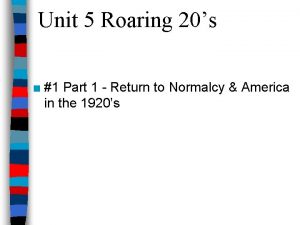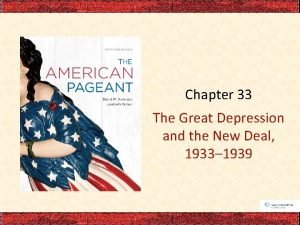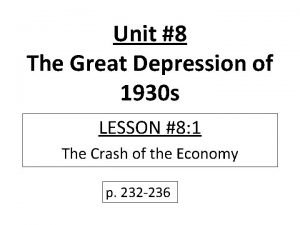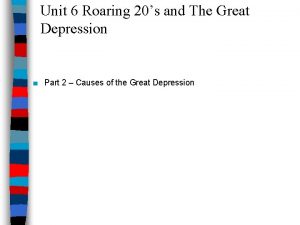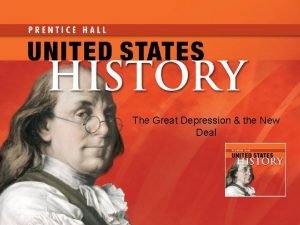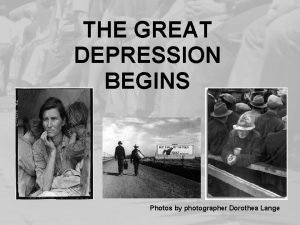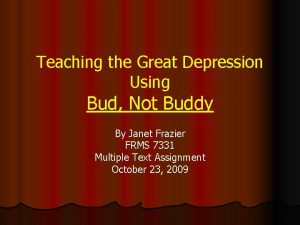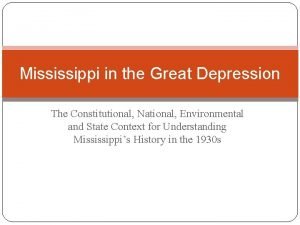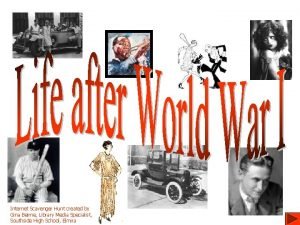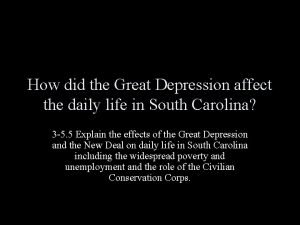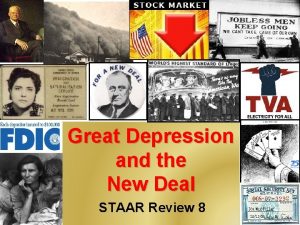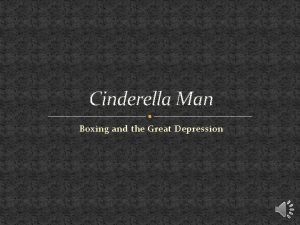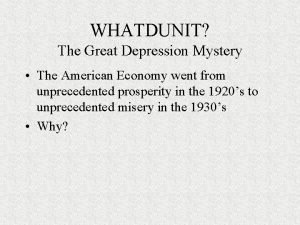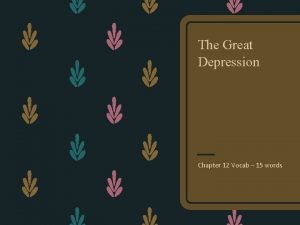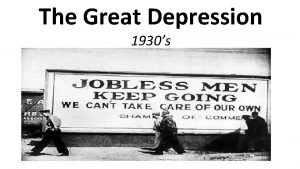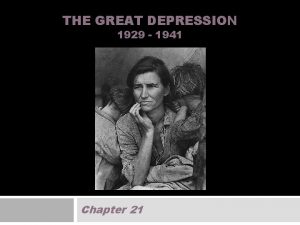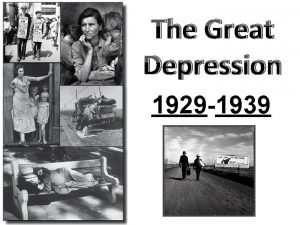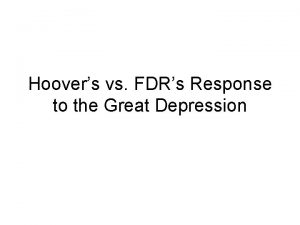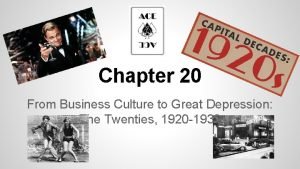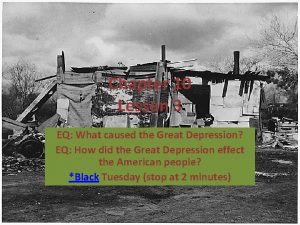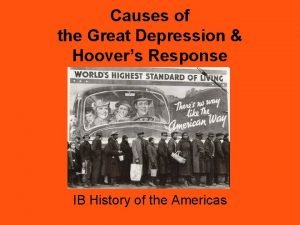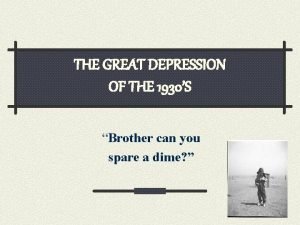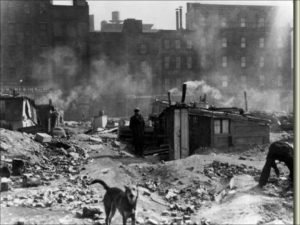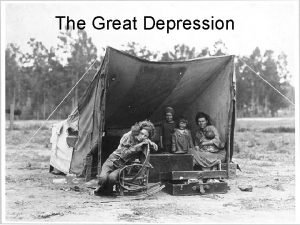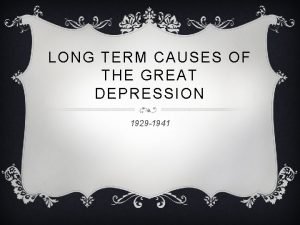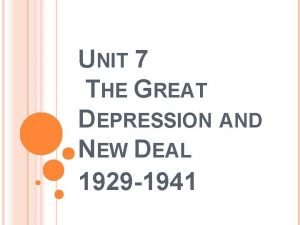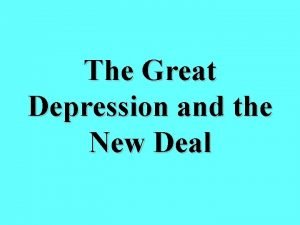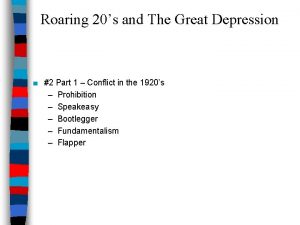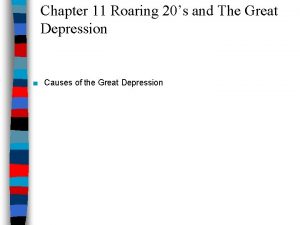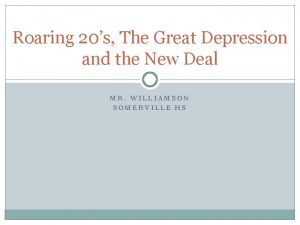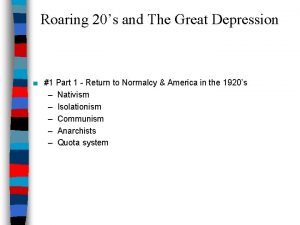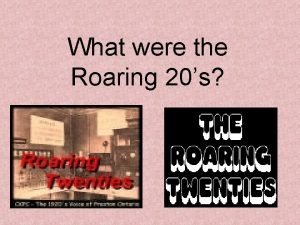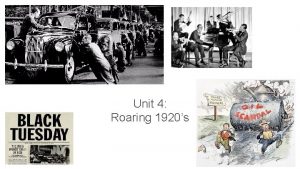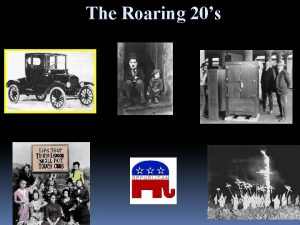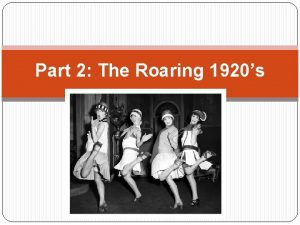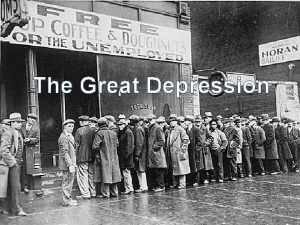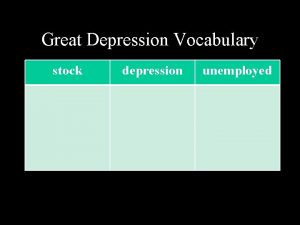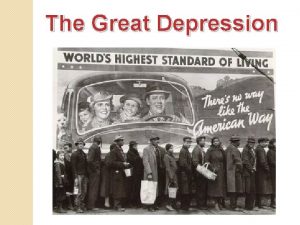Canada and the Great Depression The Roaring 20s









































































- Slides: 73

Canada and the Great Depression

The Roaring 20’s • The new concept of “credit” • People were buying: – Automobiles – Appliances – Clothes • Fun times reigned – Dancing – Flappers – Drinking

But as the 1920’s drew to a close, so did prosperity and the feelings of optimism.

• Much of what led to the Great Depression of the 1930's was a result of the prosperity of the 1920's. • Through industrialization, the economy had changed in so many ways that people did not know what the future held.

• This uncertainty and optimism led to these underlying causes of the Great Depression.

Causes of the Great Depression

1. Overproduction and Expansion Canada's companies expanded their industries so they could meet war demand. As European industry recovered, Canadian industry and agriculture were overproducing causing prices to fall.

2. Dependence On Commodity Exports Canada's economy was overly dependent on commodity exports. As U. S. and European demand fell it created a significant drop in sales causing an economical depression.

3. Dependence on U. S. Markets The US was one of Canada’s largest buyers of timber and minerals. US corporations were buying shares of Canadian industries, linking the stock markets of the two.

So there was… • Overdependence on the United States as a market and a source of investment funds

4. High Tariffs In an effort to prop up Canadian products the national government raised tariffs. The protectionist strategy backfired when other countries imposed retaliatory tariffs on Canadian goods. For example- Smoot-Hawley tariffs (made the problem worse. )

5. Too Much Credit Canadians bought too much on lease and credit including stocks. Therefore when the stock market crashed (partly due to the margin buying), Canadians were in debt. Many attempted to sell their belongings or were having their possessions repossessed.

6. The Dust Bowl The Prairies were hit extremely hard by several years of drought. Dust storms swept across the prairies, making it impossible for farmers to grow wheat. Thus, since the farmers had frequently bought their seed and machinery by using credit, when they couldn't pay off their debts, the farmers were often bankrupted and rural banks failed.


More on the drought on the Canadian Prairies • In 1929, a terrible drought began that lasted nearly 10 years. • Crops dried up and the soil turned to dust; the wind then blew away the dry soil. • Storms of dust occurred often leading parts of Alberta and Saskatchewan to be referred to as the “Dust Bowl”; also known as the Palliser Triangle • Nearly 14, 000 farms were abandoned during the depression.


• Western farmers in Canada were also unable to survive because of the failing economy in the U. S. , less demand for their products. • Finally, in 1931 -32 the first swarms of grasshoppers began destroying wheat fields across the prairies. • Many men left their small rural farming towns (especially in the prairie provinces) and moved from city to city (towards Ontario) in hopes of finding work.


7. The Stock Market Crash: October 29, 1929 • Too many people were buying stocks “on margin” which means that they borrow money from the bank in order to buy more stocks. • The crash occurred on “Black Tuesday”, October 29, 1929. • Families lost all their money, businesses went bankrupt. • Many businessmen now facing financial ruin “checked in” to multi storied hotels…and sadly “checked out” through the windows, committing suicide.


• Approximately ¼ (25%) of the population was unemployed • Current Unemployment Rate in Canada 6 -8%




The Initial Impact The Stock Market Crash had immediate and profound effects on the Canadian economy. Americans=market closed off(huge tariffs); ended investment abroad; called in loans Canadians= overproduction had created a glut of materials (wheat); no available consumers; prices fell dramatically.

The Initial Impact • The economy ground to a halt • Hundreds of thousands were unemployed. • There was no relief, no social welfare, and no unemployment insurance.

Impact in the West • Saskatchewan suffered the most. • The price of wheat per bushel fell from $1. 65 in 1929 to $0. 30 in 1931 • This devastated the provincial economy that was so dependent on the crop. • Natural disasters such as grasshoppers, rust, drought and drifting soil further compounded the troubles in agriculture. • Alberta was also hit hard for many of the same reasons.

• In Manitoba, the economy of Winnipeg collapsed when the East-West railway trade slowed down. • In BC, an economy highly dependent on minerals and timber, thousands of unemployed poured into Vancouver. • “Summer resort for Hobos”

• The impact on the Maritimes was felt to a lesser degree because the region had been in a continuous depression since Confederation. • In Southern Ontario and Montreal unemployment reached new highs as the huge manufacturing complex of Canada’s industrial heartland ground to a halt.

• The Prime Minister at the start of the Great Depression was Liberal William Lyon Mackenzie King.

Initial Response of Mackenzie King • His remedies of balancing the budget and slashing government expenditures were useless. • Desperate requests from provincial and municipal government for financial assistance were believed to be a Tory (Conservative) plot to undermine his Liberal government. • As King told the House of Commons in April, 1930: – “as far as giving moneys out of the federal treasury to any Tory government in this country for these alleged unemployment purposes I would not give them a five cent piece. ” • AKing was seen as wildly indifferent.

R. B. Bennett • R. B. Bennett, leader of the Conservative Party, was ready and waiting after King’s “ 5 cent piece comment”.

The 1930 Election and Bennett in Command • King tied to avoid the issue of the Depression. • Bennett emphasized his solution a tariff -“blast a way” into world markets. • 14% of the Canadian workforce was unemployed but to King it was not a priority campaign issue. • First federal campaign in which radio was extensively used and Bennett was good at it! • The Tories won the election by a landslide and the Depression became Bennett’s problem to solve.

Bennett in Command • Unlikely that Bennett could solve the financial crisis. • Bennett was a conservative who disliked spending money on massive public works or relief payments.


Bennett in Command • Bennett did have some early accomplishments. • First, he raised the tariff • Second, he spent ten times more on relief for the out of work than had been spent in the previous decade. • Bennett argued provinces and municipal governments would have to pay!

Bennett in Command • attempts at closer economic relations with Britain failed. • By 1933, almost one-third of Canadians were out of work during the worst year of the Depression. • Bennett’s lack of solutions had made him a highly unpopular Prime Minister.

Relief Camps and the On-To-Ottawa Trek • Bennett created relief work camps run by the Department of National Defense that provided work, food and shelter for these “single homeless persons”

Relief Camps

Relief Camps • 175, 000 “inmates” passed through the work camps. • Though some camps were well run, comfortable and treated workers with respect, many were more like prisons. • The pay was 20 cents per day, food was terrible, and bedbugs plentiful. • The work of clearing land for highways and airports in swampy, mosquito-infested areas was hard. • Also, camps were isolated in the bush, did not allow women inside and forbade entertainment or alcohol.


Relief Camps and the On-to-Ottawa Trek • Relief camp workers began to organize a Relief Camp Workers Union and took their case to the city of Vancouver. • Wanted better conditions and better pay. • From there, they decided to go directly to Ottawa to complain. • Hopping on east-bound freight trains the Onto-Ottawa Trek had begun.

The Regina Riot • The trekkers gathered more unemployed workers as they stopped in every city. • In Regina, they gathered in a stadium. • After talks collapsed, the order for trekkers to clear out of Regina was given. • The resulting Regina Riot on July 1, 1935 A police officer died in the fighting • 130 strikers were arrested.

The Regina Riot

The Regina Riot • Bennett saw the trek as the work the Communist party • He used Section 98 of the Criminal Code to arrest prominent Communists • The R. C. M. P. was order to infiltrate trade unions and other organizations. • Civil liberties were trampled in the “anti-red” (communist) hysteria of the time. • Bennett’s handling of the On-to-Ottawa Trek and the Regina Riot was seen by many as heavy-handed • King was able to exploit this during the 1935 federal election.

Impact on Canadian Women • Due to the sexism of the times, women were largely ignored during the Depression • The domestic sphere was still held to be women’s “proper place”, thus women every job held by a woman was viewed as a job taken away from a male “breadwinner”. • Most school boards, professional organization, governments, manufacturers, and retailers stopped hiring women. • Many women turned to domestic work in order to survive. • This reversed the trend of the previous two decades which had seen women moving into sales, clerical and even professional jobs.


Impact on Canadian Women • Wages for domestic workers were less than $4/week • Between 1921 and 1936 the number of domestic workers doubled but their wages decreased by half. • Also, minimum wage laws which were passed to protect women backfired • There were no specific measures for unemployed women.

New Ideas • Canadians began to examine the existing economic, social, and political systems and found them unsatisfactory. • It was in Western Canada that many alternative parties began. • In 1932 the Co-operative Commonwealth Federation was founded out of an alliance of farmer groups, socialists and labour parties.

New Ideas • The CCF’s Regina Manifesto called for an end to the capitalist system based on “domination and exploitation”. • The CCF promoted public ownership of a financial institutions, public utilities, and transportation companies. It favoured production for use rather than production for profit. • J. S. Woodsworth, a Methodist minister, was the CCF’s founder and used the Social Gospel of Christianity, rather than Marxism, to argue for socialism. • A decade later. the CCF inspired another politician Tommy Douglas who founded the NDP party.

New Ideas • The right-wing party that emerged during the thirties was Social Credit. • William “Bible Bill” Aberhart was a fundamentalist lay preacher whose fiery sermons attracted very large radio audiences in Alberta.

Social Credit • Social Credit argued governments should issue “social dividends”, or cash payments, to everyone. • Aberhart won a landslide victory to become Alberta’s Premier in 1935.

Social Credit • When Aberhart attempted to implement his Social Credit policies- disallowed by the federal authorities or by the courts. • Social Credit ended up providing Alberta with a solid, free-enterprise, conservative government for the next generation, but its theories were only used for campaign rhetoric.

• Thus, one of the important effects of the Great Depression in Canada was the emergence of viable “Third parties” and an end to the two-party system.

Bennett’s New Deal • Inspired by American policy. • Government money flowed into New Deal programs such as: – The Prairie Farm Rehabilitation Act (to restore and preserve drought-affected lands) – The Canadian Wheat Board (to administer the sale of grain and promote higher prices for wheat) – The Natural Products Marketing Board (to allow marketing boards to help farmers get higher prices for their products than the free market could provide. )

Bennett’s New Deal • Bennett proposed legislation to pave the way for unemployment insurance and national health insurance, but these programs were thwarted by the courts. • The Bank of Canada Act created a central bank to regulate credit and currency in the best interest of the country. This government agency could set more reasonable interest rates and increase the monetary supply in order to stimulate the economy. • Many Canadians viewed Bennett’s adoption of the New Deal as a ploy designed to save his highly unpopular government from defeat in the upcoming election. • Woodsworth derided Bennett’s New Deal as a “deathbed conversion”



King back in office • During the 1935 election campaign Bennett hoped his New Deal would sway Canadians. Bennett attempted to copy Roosevelt’s and Aberhart’s successes in using the radio, but to no avail. • King made few promises but did pledge to close down the relief camps. • King also ran on a campaign of “King or Chaos”, criticizing Bennett for his heavy-handed repression of the On-to-Ottawa Trek. • The October results saw King’s Liberals grab 125 seats in the House of Commons while Bennett’s Tories were reduced to only 40 seats. • Unfortunately, 5 years in opposition seemed not to have changed King in the slightest.

King Back In Office • King would say, “what is needed more than a change in economic structure is a change of heart. ” • King promised to balance the budget and slash government spending. • He also kept his promise to close the relief camps, but mostly because he viewed them as being too expensive. • King lowered the tariff and signed a trade deal with the United States in an attempt to kick-start the Canadian economy. • King did adopt a few of Bennett’s New Deal policies, but on a whole he moved slowly and cautiously. • Canadians would have to wait another 5 years before the effects of the Depression began to subside.

Depression Era Culture in Canada Longshoremen By Millar Brittain

• There was unparalleled cultural activity during the 1930’s. • In the world of painting, the Group of Seven had come together and Emily Carr was finding an audience for her work. • While the 1920 s had seen painters experimenting in abstract works, the 1930 s saw a return to realism as artists portrayed images of the unemployed, foreclosed farms and the helpless.

Group of Seven



Emily Carr


• Canadian novels in the 1930 s were escapist – an adventure, a historical romance, or a comedy. The grief of the decade was too overwhelming to write about. • Canadians flocked to Hollywood movies and tuned into their radios for American comedy and variety shows such as Amos ‘n Andy.

• Foster Hewitt and “Hockey Night in Canada” continued to be a favourite of Canadians • The CBC, created in 1936, brought popular programs such as “The Happy Gang” into people’s homes.

• The Wizard of Oz, Gone with the Wind, Frankenstein, Snow White and the Seven Dwarfs and King Kong were extremely popular during the 30’s because these films of fantasy allowed people temporarily escape from the problems of their daily lives.

Human toll • Many lost their homes and businesses. • Families were split apart in order to survive. • In some cases people felt there was no way out of the despair of the depression and suicide rates increased.

Rowell-Sirois Report • Attempts at providing relief during the Depression were exacerbated by legal issues over the division of power between the national and provincial governments under the BNAA. • Royal Commission on Dominion-Provincial Relations 1937. 1940 recommendations: – Found that provincial responsibility for health, education, and welfare had grown beyond the capacity of some provinces – Federal government should take over taxation authority and provide the provincial governments income through grants – Federal government should take responsibility for retirement pensions and unemployment insurance.

The End of The Great Depression • The common view among economic historians is that the Great Depression ended with the advent of World War II. • Many economists believe that government spending on the war caused or at least accelerated recovery from the Great Depression. • Though some consider that it did not play a very large role in the recovery, it did help in reducing unemployment and the war effort put many back to work.
 Which identifies two effects of the harlem renaissance?
Which identifies two effects of the harlem renaissance? Roaring 20s vocabulary
Roaring 20s vocabulary Demobilization and adjustment to peace 1920
Demobilization and adjustment to peace 1920 20s decade fashion
20s decade fashion The roaring twenties canada
The roaring twenties canada Roaring twenties great gatsby
Roaring twenties great gatsby Hoover and fdr compare and contrast
Hoover and fdr compare and contrast Organic chemistry third edition david klein
Organic chemistry third edition david klein Fashion in the 20s
Fashion in the 20s Depression/new deal unit vocab
Depression/new deal unit vocab Hardship and suffering during the depression
Hardship and suffering during the depression Pros and cons of the great depression
Pros and cons of the great depression What is the main idea of the cartoon?
What is the main idea of the cartoon? Chapter 33 the great depression and the new deal
Chapter 33 the great depression and the new deal Rarig great depression
Rarig great depression Great depression
Great depression The ingenious quarterback analysis
The ingenious quarterback analysis Foreclosure great depression
Foreclosure great depression Five effects of the great depression
Five effects of the great depression Five effects of the great depression
Five effects of the great depression How did the great depression impact the world
How did the great depression impact the world What is the dawes plan
What is the dawes plan Bud not buddy
Bud not buddy Pantoum of the great depression analysis
Pantoum of the great depression analysis Summary of great depression
Summary of great depression Cpi during the great depression
Cpi during the great depression Okies great depression
Okies great depression The great depression leq
The great depression leq Five effects of the great depression
Five effects of the great depression How did the great depression affect south carolina
How did the great depression affect south carolina What caused the dust bowl
What caused the dust bowl Great depression causes
Great depression causes Brief summary of the great depression
Brief summary of the great depression Cinderella man great depression
Cinderella man great depression Birth rate during the great depression
Birth rate during the great depression Overspeculation great depression
Overspeculation great depression Great depression vocab
Great depression vocab Great depression vocabulary
Great depression vocabulary Great depression bank runs
Great depression bank runs Http://www.history.com/topics/great-depression
Http://www.history.com/topics/great-depression Rrr great depression
Rrr great depression Hawley-smoot tariff great depression
Hawley-smoot tariff great depression Stock market crash cartoon 1929
Stock market crash cartoon 1929 Great depression budget activity
Great depression budget activity Fdrs response to the great depression
Fdrs response to the great depression Laissez faire great depression
Laissez faire great depression Laissez faire great depression
Laissez faire great depression Chapter 20 from business culture to great depression
Chapter 20 from business culture to great depression Great depression acrostic poem
Great depression acrostic poem Hoovervilles great depression
Hoovervilles great depression What is the message of this political cartoon
What is the message of this political cartoon Great depression vocabulary jeopardy
Great depression vocabulary jeopardy Chapter 22 the great depression begins
Chapter 22 the great depression begins Great depression
Great depression Great depression webquest
Great depression webquest Social context of to kill a mockingbird
Social context of to kill a mockingbird Hoovers response to the great depression
Hoovers response to the great depression Great depression
Great depression What was hoover's response to the great depression
What was hoover's response to the great depression Great depression
Great depression Great depression
Great depression Great depression drawing
Great depression drawing High tariffs great depression
High tariffs great depression Great depression photographer
Great depression photographer What was hoover’s response to the depression?
What was hoover’s response to the depression? Great depression
Great depression Hoovers poor farm tobacco fund
Hoovers poor farm tobacco fund What were the long term causes of the great depression
What were the long term causes of the great depression The great depression outline
The great depression outline The notebook
The notebook New deal
New deal Hawley smoot tariff apush
Hawley smoot tariff apush Wall street crash of 1929
Wall street crash of 1929 What was the great depression
What was the great depression








